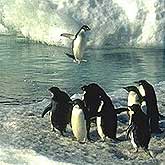Antarctica and Climate Change
 Because of its influence on world weather and climate patterns, Antarctica lies at the heart of the debate on climate change and has become the premier location in which to study the effects of global warming. Over the course of the past 50 years, Antarctica's average year-round temperature has warmed by about 3-4 degrees Fahrenheit - more than 10 times the average worldwide increase during that period. As a result of these increases in temperature (which are not necessarily the result of global warming), the Antarctic continent has experienced changes in its landscape and ecology. Scientists are also concerned that with such dramatic increases in the icy continent's temperature, significant rises in global sea levels could occur if Antarctica's thick polar ice sheet melts. The West Antarctic ice sheet alone, if melted, could raise average sea levels around the world by about 20 feet, resulting in the flooding of low-lying coastal zones.
Because of its influence on world weather and climate patterns, Antarctica lies at the heart of the debate on climate change and has become the premier location in which to study the effects of global warming. Over the course of the past 50 years, Antarctica's average year-round temperature has warmed by about 3-4 degrees Fahrenheit - more than 10 times the average worldwide increase during that period. As a result of these increases in temperature (which are not necessarily the result of global warming), the Antarctic continent has experienced changes in its landscape and ecology. Scientists are also concerned that with such dramatic increases in the icy continent's temperature, significant rises in global sea levels could occur if Antarctica's thick polar ice sheet melts. The West Antarctic ice sheet alone, if melted, could raise average sea levels around the world by about 20 feet, resulting in the flooding of low-lying coastal zones.
The effects of climate change on Antarctica vary from migrations of seal and penguin populations to other parts of the continent to abrupt changes in the glacial landscape. In March, 2000 the Larson B ice shelf in northern Antarctica - an area the size of Delaware - broke away from the continent and retreated into the sea. Similarly, in January, 1995, the Larson A ice shelf calved away from the continent, disappearing into the sea and bringing with it part of an Argentine base camp. Ice shelf instability is created as a result of higher sea and air temperatures, and a number of northern ice shelves have displayed similar trends such as the Wordie, Muller and Prince Gustav Channel shelves.
Perhaps most vulnerable to the effects of Antarctic climate change are the continent's wildlife populations. Increasing temperatures, less ice, and more snowfall have altered the patterns and habitats of several Antarctic species, such as the southern fur and elephant seals and Adelie and Chinstrap penguins. Although the past 20 years have seen an increase in the numbers of Chinstrap penguins on the continent, the opposite is true for the Adelie penguin. Rising Antarctic temperatures also have resulted in more snowfall on the continent; making breeding difficult for the ice-loving Adelie penguins. Seal populations, on the other hand, have benefited from the reduction in sea ice as they prefer breeding and feeding in open waters. Several seal populations in Antarctica have increased their numbers by over 300% in the last 20 years.
Fact Credit
DOE Department of Energy


